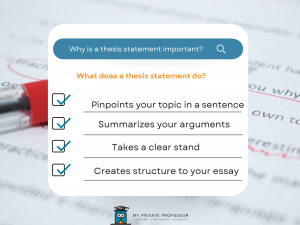Thesis statements can be a challenge when students aren’t sure how to get started or what “a strong thesis statement” even entails. Fully grasping the thesis statement is a great way to get one step closer to mastering essay-writing.
What is the purpose of a thesis statement?
Your thesis statement helps you communicate your key argument(s) in one or two sentences. This statement allows your reader to follow along more cohesively. Plus, it acts somewhat as the backbone of your paper, and makes the process more organized for both you and your reader(s).
Essentially, your thesis will comprise your central ideas and argument. However, it’s not just any ideas—it’s the specific ideas around which you structure your paper. Or, more accurately, it’s the stance you take.
What makes a strong thesis statement?
A strong thesis statement includes the what and the why. That is, you’ll explain what you’re talking about, and why it’s important to discuss.
Why are you writing about this, why is it relevant, and why should your readers side with you?
A strong thesis statement is narrow
While it can be tempting to try and fit every single one of your thoughts into one paper, this usually isn’t possible—or enjoyable for the reader, who may find it impossible to follow your words. Narrowing your statement will make your paper flow better. It will also make the process seem less overwhelming, since you’ll have specific ideas to research rather than a textbook’s worth of information.
A strong thesis statement warrants discussion and debate
Basically, your thesis isn’t going to be a straightforward statement or fact—it’s something that’s debatable. The whole point of your essay is to argue your perspective, which, in a couple sentences, comprises your thesis statement.
The bulk of your essay is your justification for this statement. So your reader is spending time evaluating your justification and determining whether they agree or disagree with the initial statement.
A strong thesis statement requires evidence
Essentially, you must be able to demonstrate your thesis through evidence. And this evidence may be news articles, books, videos, interviews, or encyclopedias.
This means that your thesis statement shouldn’t encapsulate everything you want to say about the topic. You’ll do this with your evidence.
This “evidence” is your body paragraphs. Within each body paragraph, you’ll provide evidence that ultimately supports your thesis statement and encourages readers to take your perspective—and continue reading.
Thesis statement tips
Write the paper first
It can be overwhelming to sit down with a blank piece of paper and pull together a brilliant thesis in one go. Many students find that writing the paper first is easier. This is because, first of all, there’s less pressure. Secondly, you’ll be more organized when you have all your points and evidence laid out in front of you.
Determine your key questions
Your thesis should comprise the key questions you’ll be asking. Try writing down the main questions you want to ask. Then, in doing your research, identify the answers. These answers will make up your body paragraphs. 
Tailor your thesis to the essay type
You can tweak your thesis statement to fit a certain type of paper—and doing so will make the essay stronger. Thinking about the different types of essays is helpful in understanding how to best craft your thesis.
Analytical essays
For instance, when writing an analytical paper, you’ll want to effectively communicate your interpretation of whatever you’re talking about. This type of thesis should capture the conclusion you’ve come to through your analysis. You can make this clearer by explicitly stating the points of analysis you’ll be walking the reader through.
Example: An analysis of college students and mental health reveals that the role of social media contributes to overall stress and anxiety levels.
The above example primes the reader for what you’ll be discussing—an analysis of college students, mental health, and the role of social media. Plus, the thesis includes your general conclusion, which should be the basis upon which you find your evidence.
Persuasive essays
When writing a persuasive essay, your thesis statement should be a bit more of a definitive declaration that affirms your stance and has distinct opposing perspectives. That is, your reader should be able to clearly see that your topic is debatable.
Example: Because art classes provide students with a more rounded education, schools should continue offering art classes at all ages.
This is an example of a persuasive thesis—you’re arguing that schools could offer art classes, and readers may choose to agree with your perspective, or believe otherwise.
Expository essays
For n expository paper, it may be more difficult to craft a thesis, since expository essays are ultimately a detailed, informational breakdown of a specific topic. So your thesis statement may be more descriptive than argumentative. Your statement can help summarize your main points and the intention of your essay.
Example: Advancements in technology within the past couple decades have coincided with a decrease in levels of emotional intelligence and empathy.
In addition to providing your main opinion, you put forward a fact. At the same time, the above thesis statement is open-ended and as such, leaves the door open for you to elaborate through your writing.
Author: Lydia Schapiro









Leave A Comment